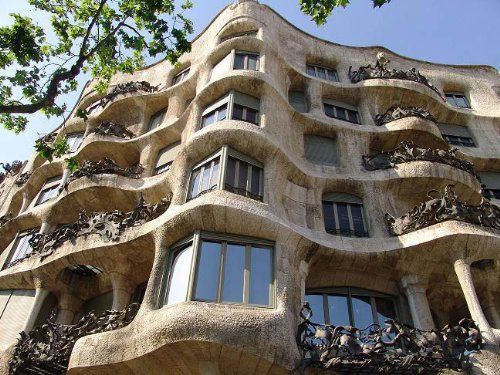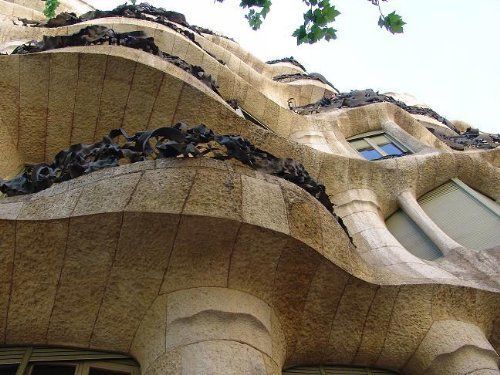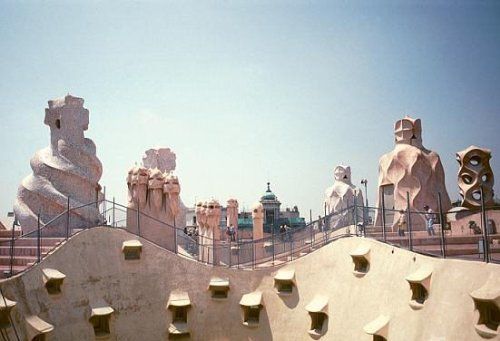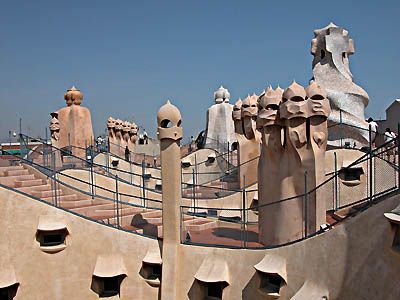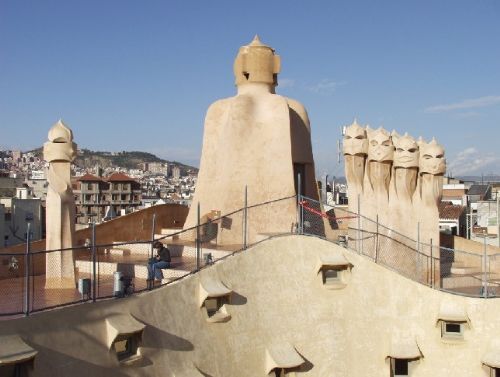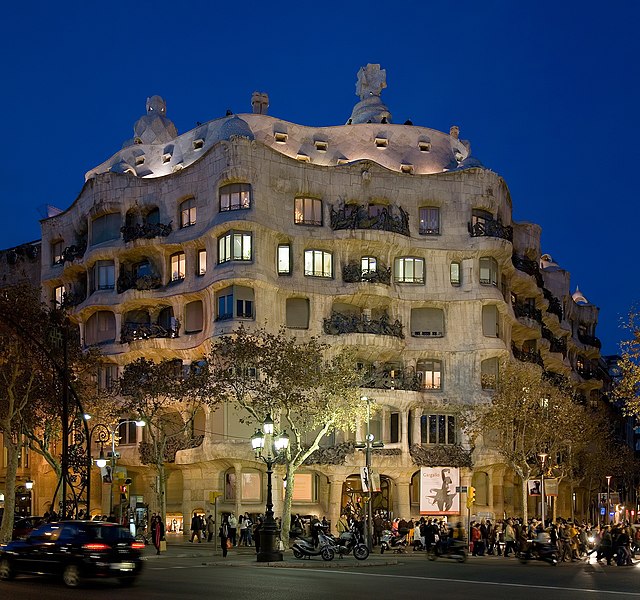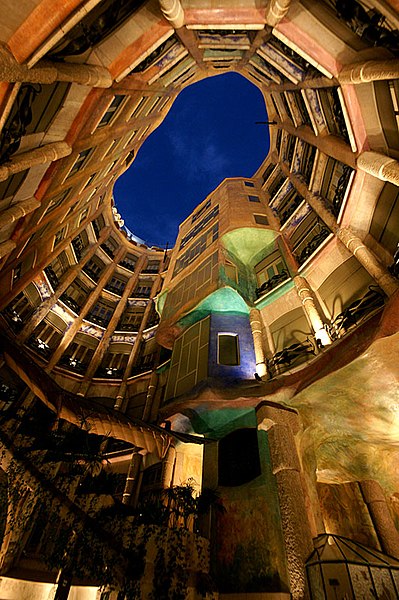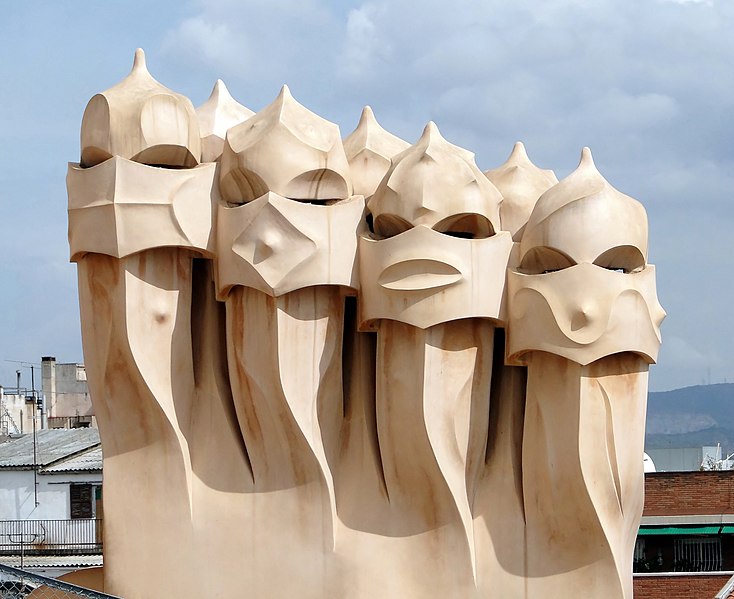米拉公寓的外形 在巴塞羅那帕塞奧·德格拉西亞大街上,坐落著一幢聞名全球的純粹現代風格的樓房——米拉公寓。老百姓多把它稱為“石頭房子”。它的設計者就是被譽為“上帝的建築師”的天才大師安東尼奧·高迪。高迪一生留下無數知名建築,也讓人感慨,“沒有哪座城市會像巴塞羅那,因一個人(高迪)而變得熠熠生輝。”
渾然天成的感覺 米拉公寓於1906~1910年在西班牙巴塞羅那建成。設計米拉公寓的西班牙著名建築師安東尼奧。高迪(Atonio Gaudi,1852—1926年)是在建築藝術探新中勇於開辟另一條道路的人,他以浪漫主義的幻想極力使塑性藝術滲透到三度空間的建築中去,在米拉公寓設計中,把重點放在造型的藝術表現方麵。他發揮想象力,建築形象奇特,怪誕不經。同時吸收了伊斯蘭建築的風格,與哥特式建築的結構特點相結合,采取自然的形式,精心去探索他獨創的塑性建築楷模。
內部裝飾精致入微 這幢建築完工時因其先鋒性質和大膽的手法而引起了極大的騷動。許多人認為這幢房子代表了現代派的頂峰,20世紀全世界最奇特的建築物。 這是一尊由波浪型的曲線構成的巨大石造紀念碑,形狀扭曲奇特的通風口,石塊好像都是液體的,有機的,房頂上的煙囪和通風口成了幻影似的戰士,抽象的陶瓷拚花螺旋,驚人想象力的魔幻森林。米拉公寓使得Passeig de Gràcia大街上的其他建築多少有些平淡無奇。米拉之家是用一組組石質隔牆和柱子為結構,大的陽台和窗戶,中間有兩個天井。不同高度的頂樓形成,有波狀的樓頂,獨特的陽台和窗戶設計,再加上巨大神秘造型的通風口,在當時引起相當大的騷動,人們認為此建築若非出自惡魔之手就是瘋子所為。
20世紀全世界最奇特的建築物 米拉公寓以取材於海浪的波浪造型和鑄鐵的陽台扶欄著稱
用柔和的線條去表現一切 在高迪的眼中,直角是人為的,大自然中不存在直角的物體。高迪的一切靈感來源於自然和幻想:海浪的弧度、海螺的紋路、蜂巢的格致、神話人物的形狀,都是他酷愛采用的表達方式,他痛恨硬邦邦的直線,他喜歡用柔和的曲線和五彩的顏色表達一切。
造型奇特的煙囪 甚至每一個煙囪的造型、每一塊磚的擺法,高迪都有興趣玩味半天。他喜歡慢慢地讓靈感萌芽、開花,他享受這樣的過程。新
米拉公寓 佩雷·米拉是個富翁,他和妻子參觀了巴特略公寓後羨慕不已,決定造一座更加令人歎為觀止的建築。米拉找到了紅極一時的青年建築師高迪,請他來設計、建造,並答應給他充分的創作和行動自由。不過事後他才發覺,他的這一允諾是有欠考慮的。
內部設計欣賞 工程熱火朝天地展開了。米拉卻在工地上憂心如焚地打轉轉,因為他心裏有許多問題百思而不得其解:為什麽工程已開工卻不見圖紙?為什麽沒有預算?為什麽沒有設計方案?如此等等。高迪默不作聲——語言不是他表達意見惟一的和最好的方式。不過,終於有一天,他沉不住氣了,從口袋裏摸出一張揉得皺巴巴的紙片,衝著米拉說:“這就是我的公寓設計方案!
米拉公寓屋頂造型 這個公寓的屋頂造型相當怪異,似乎外星人更容易通過這些圖形與大師溝通房
米拉公寓 米拉公寓位於街道轉角,地麵以上共六層(含屋頂層),屋頂高低錯落,牆麵凸凹不平,到處可見蜿蜒起伏的曲線。屋簷和屋脊有高有低,呈蛇形曲線。整座大樓仿佛是一座被海水長期浸蝕又經風化布滿孔洞的岩體,牆體本身也像波濤洶湧的海麵,富於動感。
米拉公寓陽台:這裏看到鐵匠世家出身的高迪對鐵材質的創造運用 米拉公寓的陽台欄杆由扭曲回繞的鐵條和鐵板構成,如同掛在岩體上的一簇簇雜亂的海草。米拉公寓的平麵布置也不同一般,牆線曲折彎扭,房間的平麵形狀也幾乎全是“離方遁圓”,沒有一處是方正的矩形。公寓屋頂上有六個大尖頂和若幹小的奇形怪狀突出物體,其造型有的似神話中的怪曾,有的如螺旋體,有的像披上全副盔甲的軍士,有的像神話中的怪獸,有的像教堂的大鍾,有的如無名的花蕾、如骷髏、如天外來客……。其實,這是特殊形式的煙囪和通風管道。後來它們與古埃爾公園和聖家族大教堂一樣,也成了巴塞羅那的象征。http://sy.bbs.house.sina.com.cn/thread-8085270-1.html Casa MilàFrom Wikipedia Coordinates:  41°23′43″N 2°09′42″E 41°23′43″N 2°09′42″E
Casa Milà (Catalan pronunciation: [ˈkazə miˈɫa]), better known as La Pedrera (pronounced: [ɫə pəˈðɾeɾə], meaning the 'The Quarry'), is a building designed by the Catalan architect Antoni Gaudí and built during the years 1905–1910, being considered officially completed in 1912. It is located at 92, Passeig de Gràcia (passeig is Catalan for promenade) in the Eixample district of Barcelona, Catalonia, Spain. It was a controversial design at the time for the bold forms of the undulating stone facade and wrought iron decoration of the balconies and windows, designed largely by Josep Maria Jujol, who also created some of the plaster ceilings. Architecturally it is considered an innovative work for its steel structure and curtain walls – the façade is self-supporting. Other innovative elements were the construction of underground car parking and separate lifts and stairs for the owners and their servants. In 1984, it was declared World Heritage by UNESCO. The building is made open to the public by the CatalunyaCaixa Foundation, which manages the various exhibitions and activities and visits to the interior and roof. HistoryIt was built for the married couple, Roser Segimon and Pere Milà. Roser Segimon was the wealthy widow of Josep Guardiola, an Indiano, a term applied locally to the Catalans returning from the American colonies with tremendous wealth. Her second husband, Pere Milà, was a developer who was criticized for his flamboyant lifestyle and ridiculed by the contemporary residents of Barcelona, when they joked about his love of money and opulence, wondering if he was not rather more interested in "the widow’s guardiola" (piggy bank), than in "Guardiola’s widow".[1] Gaudi, a Catholic and a devotee of the Virgin Mary, planned for the Casa Milà to be a spiritual symbol.[2] Overt religious elements include an excerpt from the Rosary prayer on the cornice and planned statues of Mary, specifically Our Lady of the Rosary, and two archangels, St. Michael and St. Gabriel.[2][3] The design by Gaudi was not followed in some aspects. The local government objected to some aspects of the project, fined the owners for many infractions of building codes, ordered the demolition of aspects exceeding the height standard for the city.[4] The Encyclopedia of Twentieth Century Architecture states that the statuary was indeed Mary the mother of Jesus, also noting Gaudi's devoutness, and notes that the owner decided not to include it after Semana Trágica, an outbreak of anticlericalism in the city.[2] After the decision was made to exclude the statuary of Mary and the archangels, Gaudi contemplated abandoning the project but was persuaded not to by a priest.[3] Casa Milà was in poor condition in the early 1980s. It had been painted a dreary brown and many of its interior color schemes had been abandoned or allowed to deteriorate, but it has since been restored and many of the original colors revived. Noteworthy
Architecture
Scale model at the Catalunya en Miniatura park
Casa Milà was a predecessor of some buildings with a similar biomorphic appearance:
Free exhibitions often are held on the first floor, which also provides some opportunity to see the interior design. There is a charge for entrance to the apartment on the second floor and the roof. The other floors (3-5) are not open to visitors. Casa Milà in the media and literature
Gallery
See alsoReferences
External links |
個人資料
最新文章
文章分類
歸檔
2008 (4)
2009 (169)
2010 (680)
2011 (872)
2012 (1247)
2013 (1564)





